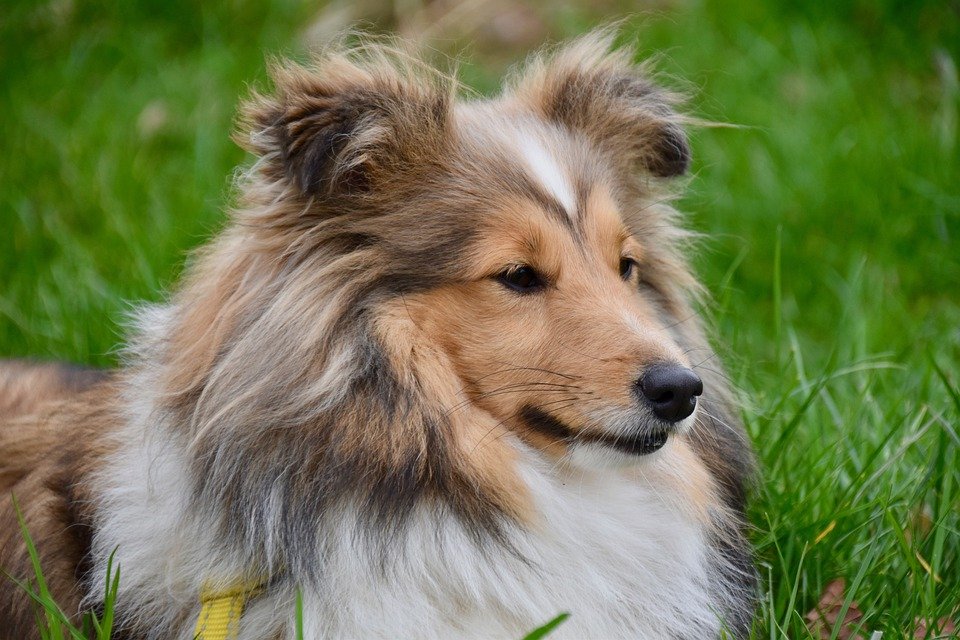The Shetland Sheepdog, often known as the Sheltie, is a breed of herding dog that originated in the Shetland Islands of Scotland. The original name was Shetland Collie, but this caused controversy among the Rough Collie breeders of the time, so the breed’s name was formally changed. This hard-working small dog is intelligent, vocal, excitable and willing to please. They are incredibly loyal to their owners to the point where they are often referred to as “shadows” due to their attachment to family. This breed was formally recognized by The Kennel Club (UK) in 1909.
Like the Shetland pony, Shetland cattle and the Shetland sheep, the Shetland Sheepdog is a hardy but diminutive breed developed to thrive amidst the harsh and meagre conditions of its native islands. While the Sheltie still excels at herding, today it is often raised as a farm dog and/or family pet.
The Sheltie’s origins are obscure, but it is not a direct descendant of the Rough Collie, which it largely resembles. Rather, the Sheltie is a descendant of small specimens of the Scottish Collie and King Charles Spaniel. They were originally a small mixed-breed dog, often only about 20 to 30 centimetres (8 to 12 inches) in height at the shoulder, and it is thought that the original Shetland herding dogs were of the Spitz type, and were crossed with Collies from mainland Britain. In the early 20th century, James Loggie added a small Rough Collie to the breeding stock and helped establish the breed that would become the modern Shetland Sheepdog.
Coat and colours
Shelties have a double coat, which means that they have two layers of fur that make up their coat. The long, rough guard hairs lie on top of a thick, soft undercoat. The guard hairs are water-repellent, while the undercoat provides relief from both high and low temperatures.
The English Kennel Club describes three different colours: “tricolour, blue merle, and sable (ranging from golden through mahogany), marked with varying amounts of white and/or tan.” Essentially, however, a blue merle dog is a genetically black dog, either black, white, and tan (tricolour). In the show ring, blue merles may have blue eyes; all other colours must have brown eyes.
History
Unlike many miniature breeds that resemble their larger counterparts, this breed was not developed simply by selectively breeding the Rough Collie for the smaller and smaller size. The original sheepdog of Shetland was a Spitz-type dog, probably similar to the modern Icelandic Sheepdog. This dog was crossed with mainland working collies brought to the islands, and then after being brought to England, it was further extensively crossed with the Rough Collie, and other breeds including some or all of the extinct Greenland Yakki, King Charles Spaniel (not the Cavalier), the Pomeranian, and possibly the Border Collie. The original Spitz-type working sheepdog of Shetland is now extinct, having been replaced for herding there by the Border Collie. Shelties were used for herding until commercial livestock farming required larger breeds.
When the breed was originally introduced breeders called them Shetland Collies, which upset Rough Collie breeders, so the name was changed to Shetland Sheepdog. During the early 20th century (up until the 1940s), additional crosses were made to Rough Collies to help retain the desired Rough Collie type the first AKC Sheltie champion’s dam was a purebred rough Collie.
The year 1909 marked the initial recognition of the Sheltie by the English Kennel Club, with the first registered Sheltie being a female called Badenock Rose. The first Sheltie to be registered by the American Kennel Club was “Lord Scott” in 1911.
Working life
As the name suggests, Shelties can and have been used as sheepdogs and still participate in sheepdog trials to this day. Herding dogs conduct livestock from one place to another by causing fear-flocking and flight behaviour. The instinct to herd is primarily a product of breeding. No amount of training can substitute this trait.
Shelties can also be great therapy dogs for those who need comfort during hard times such as natural disasters or severe illness. This breed is rarely aggressive and tends to do well with children and being handled by them.
